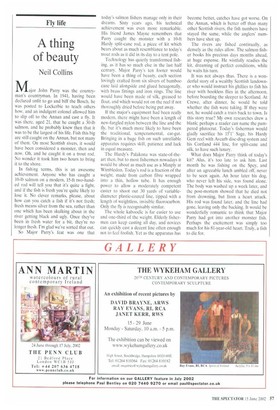A thing of beauty
Neil Collins
Major John Parry was the countryman's countryman. In 1941, having been declared unfit to go and biff the Bosch, he was posted to Lockerbie to teach others how, and an indulgent colonel allowed him to slip off to the Annan and cast a fly. It was there, aged 21, that he caught a 30-lb salmon, and he probably knew then that it was to be the largest of his life. Fish this big are still caught on the Annan, but not many of them. On most Scottish rivers, it would have been considered a monster, then and now. Oh, and he caught it on a trout rod. No wonder it took him two hours to bring it to the shore.
In fishing terms, this is an awesome achievement. Anyone who has caught a 10-1b salmon on a modern, 15-ft two-handed rod will tell you that it's quite a fight, and if the fish is fresh you're quite likely to lose it. No clever remarks, please, about how can you catch a fish if it's not fresh; fresh means silver from the sea, rather than one which has been skulking about in the river getting black and ugly. Once they've been in fresh water for a bit, they're no longer fresh. I'm glad we've sorted that out.
So Major Parry's feat was one that today's salmon fishers manage only in their dreams. Sixty years ago, his technical achievement was even more remarkable. His friend James Mayne remembers that Parry caught the monster with a 10-ft Hardy split-cane rod, a piece of kit which bears about as much resemblance to today's trout rods as it did in its day to a tent pole.
Technology has quietly transformed fishing, as it has so much else in the last half century. Major Parry's ten footer would have been a thing of beauty, each section lovingly crafted from six slivers of bamboo cane laid alongside and glued hexagonally, with brass fittings and iron rings. The line would have been made of silk, greased to float, and which would rot on the reel if not thoroughly dried before being put away.
If the major's equipment had been really modern, there might have been a length of new-fangled nylon between the line and the fly, hut it's much more likely to have been the traditional, temperamental, cat-gut. Bringing in a huge fish on such unreliable apparatus requires skill, patience and luck in equal measure.
The Hardy's Palakona was state-of-theart then, but to most fishermen nowadays it would be about as much use as a Maxply at Wimbledon. Today's rod is a fraction of the weight, made from carbon fibre wrapped into a thin, hollow tube. It has enough power to allow a moderately competent caster to shoot out 30 yards of variablediameter plastic-coated line, tipped with a length of weightless, invisible fluorocarbon. Only the fly is recognisably similar.
The whole kaboodle is far easier to use and one-third of the weight. Elderly fishermen can keep casting all day, and novices can quickly cast a decent line often enough not to feel foolish. Yet as the apparatus has become better, catches have got worse, On the Annan, which is better off than many other Scottish rivers, the fish numbers have stayed the same, while the anglers' numbers have shot up.
The rivers are fished continually, as densely as the rules allow. The salmon fisher books his precious days months ahead, at huge expense. He wistfully readies the kit, dreaming of perfect conditions, while he waits his turn.
It was not always thus. There is a wonderful story of a wealthy Scottish landowner who would instruct his ghillies to fish his river with hookless flies in the afternoon, before boarding the sleeper to Scotland. At Crewe, after dinner, he would be told whether the fish were taking. If they were not, he would catch a train back to town. Is this story true? My own researches drew a blank; perhaps a reader can name the pampered plutocrat. Today's fisherman would gladly sacrifice his 151" Sage, his Hardy Gem reel with Avcarb disc-drag system and his Cortland 444 line, for split-cane and silk, to have such luxury.
What does Major Parry think of today's kit? Alas, it's too late to ask him. Last month he was fishing on the Spey, and after an agreeable lunch ambled off, never to be seen again. An hour later his dog, who never left his side, was found alone. The body was washed up a week later, and the post-mortem showed that he died not from drowning, but from a heart attack. His rod was found later, and the line had gone, leaving only the backing. It would be wonderfully romantic to think that Major Parry had got into another monster fish. Perhaps the excitement was simply too much for his 81-year-old heart. Truly, a fish to die for.


































































 Previous page
Previous page